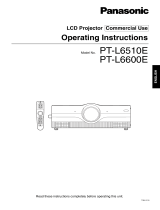
Contents
ENGLISH - 13
Important
Information
PreparationGetting StartedBasic OperationSettingsMaintenanceAppendix
[DISPLAY LANGUAGE] menu ...................81
Changing the display language ........................ 81
[3D SETTINGS] menu (PT-DZ21KU and
PT-DS20KU only) .................................. 82
[3D SYSTEM SETTING] ..................................82
[3D SYNC SETTING] ......................................82
[3D SIMUL INPUT SETTING] ..........................83
[3D INPUT FORMAT] ......................................84
[LEFT/RIGHT SWAP] ......................................84
[3D COLOR MATCHING] ................................84
[3D PICTURE BALANCE] ...............................85
[DARK TIME SETTING] ..................................85
[3D FRAME DELAY]........................................86
[3D TEST MODE] ............................................86
[3D TEST PATTERN] ......................................86
[SAFETY PRECAUTIONS MESSAGE] ...........87
[3D SAFETY PRECAUTIONS] ........................87
[DISPLAY OPTION] menu ......................... 88
[COLOR MATCHING] ......................................88
[LARGE SCREEN CORRECTION] ..................89
[SCREEN SETTING] (PT-DZ21KU and
PT-DS20KU only) .....................................90
[AUTO SIGNAL] ..............................................90
[AUTO SETUP] ............................................... 91
[RGB IN] (supported during RGB signal
input only) .................................................92
[DVI-D IN] ........................................................92
[HDMI IN] ........................................................93
[SDI IN] (PT-DZ21KU and PT-DS20KU only) ...93
[ON-SCREEN DISPLAY] .................................94
[BACK COLOR] ..............................................95
[STARTUP LOGO] ..........................................95
[UNIFORMITY] ................................................95
[SHUTTER SETTING] .....................................96
[FREEZE] ........................................................96
[WAVEFORM MONITOR] ................................96
[CUT OFF] ......................................................98
[PROJECTOR SETUP] menu .................... 99
[PROJECTOR ID] ............................................99
[PROJECTION METHOD] ...............................99
[COOLING CONDITION] ............................... 100
[HIGH ALTITUDE MODE] .............................. 100
[LAMP SELECT] ........................................... 100
[LAMP RELAY] .............................................. 101
[BRIGHTNESS CONTROL] ........................... 102
[STANDBY MODE] ........................................ 106
[SCHEDULE] .................................................106
[RS-232C] ..................................................... 108
[STATUS] ...................................................... 109
[NO SIGNAL SHUT-OFF] .............................. 110
[REMOTE2 MODE] ....................................... 110
[FUNCTION BUTTON] .................................. 110
[DATE AND TIME] ......................................... 110
[LENS CALIBRATION] ...................................111
[LENS MEMORY] .......................................... 112
[SAVE ALL USER DATA] ............................... 113
[LOAD ALL USER DATA] .............................. 113
[INITIALIZE]................................................... 114
[SERVICE PASSWORD] ............................... 114
[P IN P] menu ...........................................115
Using P IN P functions ................................... 115
Setting P IN P functions ................................. 115
[TEST PATTERN] menu ...........................117
[TEST PATTERN] .......................................... 117
[SIGNAL LIST] menu ...............................118
Registering a signal to the list ........................ 118
Renaming the registered data ....................... 118
Deleting the registered data ........................... 118
Protecting the registered data ........................ 119
Expanding signal lock-in range ...................... 119
Managing the sub memory list ....................... 120
[SECURITY] menu ...................................121
[SECURITY PASSWORD] ............................. 121
[SECURITY PASSWORD CHANGE] ............. 121
[DISPLAY SETTING] ..................................... 122
[TEXT CHANGE] ........................................... 122
[CONTROL DEVICE SETUP] ........................ 122
[CONTROL DEVICE PASSWORD CHANGE]
... 124
[NETWORK] menu ...................................125
[NETWORK SETUP] ..................................... 125
[NETWORK CONTROL] ............................... 125
[NETWORK STATUS] ...................................125
Network connections ..................................... 126
Accessing from the Web browser .................. 127
Maintenance
Lamp/Temperature/Filter Indicators .......142
Managing the indicated problems ..................142
Maintenance/replacement .......................144
Before maintaining/replacing the unit ............. 144
Maintenance .................................................144
Replacing the unit .......................................... 146
Troubleshooting ......................................151
Self-diagnosis display .............................153




















